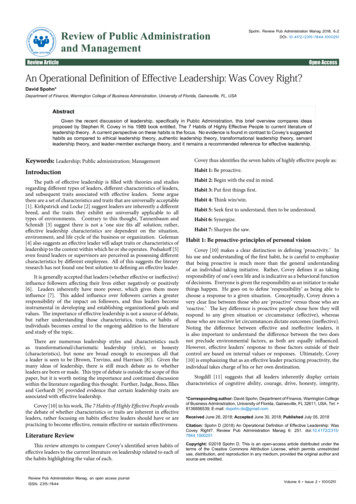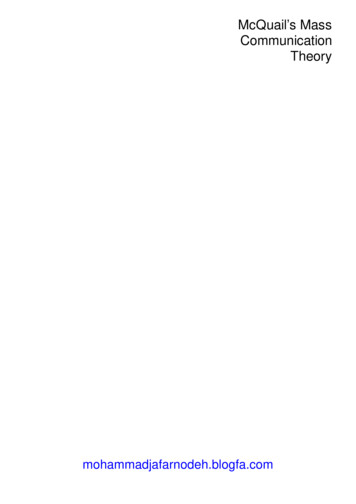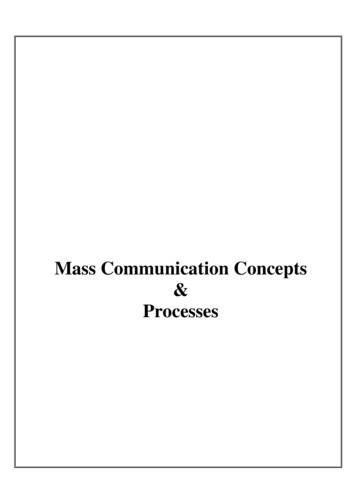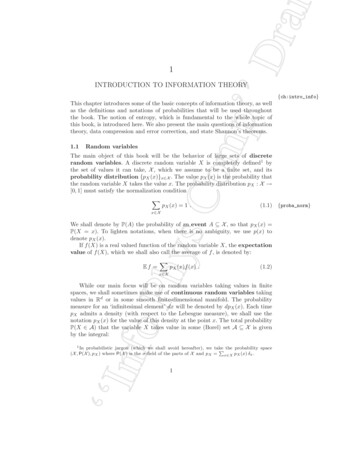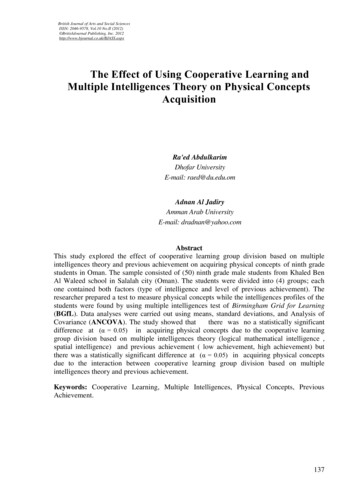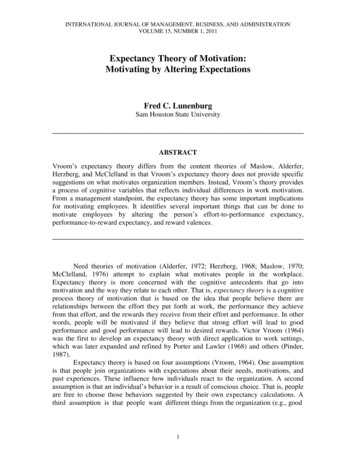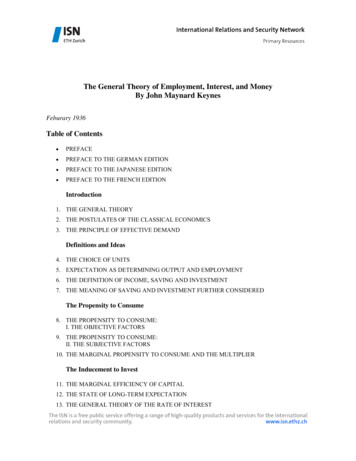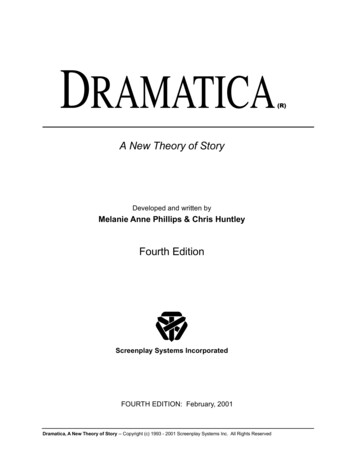
Transcription
DRAMATICA(R)A New Theory of StoryDeveloped and written byMelanie Anne Phillips & Chris HuntleyFourth EditionScreenplay Systems IncorporatedFOURTH EDITION: February, 2001Dramatica, A New Theory of Story -- Copyright (c) 1993 - 2001 Screenplay Systems Inc. All Rights Reserved1.
The Dramatica Theory was developed by Melanie AnnePhillips and Chris Huntley and was not researched norbased upon any other theories of story design or analysis.NOTE: This special fourth edition is only available inelectronic form and differs from the third edition in one significant aspect. Some of the terminology in this version hasbeen updated to match the language changes made in the4.0 version of the Dramatica software. Otherwise, thisversion is comparable to the third edition published in 1996.Copyright NoticeCopyright 1993, 1994, 1996, 2001 by ScreenplaySystems Incorporated. ALL RIGHTS RESERVED. No partof this publication may be reproduced, transmitted, transcribed, stored in a retrieval system, or translated into anyhuman or computer language, in any form or by any meanswhatsoever, without the express written permission ofScreenplay Systems Incorporated, 150 East Olive Avenue,Suite 203, Burbank California 91502, United States ofAmerica. Phone: (818) 843-6557. Internet Electronic MailAddress: DRAMATICA@SCREENPLAY.COMTrademarksDramatica is a trademark of Screenplay Systems Incorporated. Scriptor and Screenplay Systems are trademarksof Screenplay Systems Incorporated. References may bemade in this manual to "Macintosh"; this name is a trademark of Apple Computer, Inc. References may be made inthis manual to IBM and-Windows; this name is a trademarkof IBM &/or Microsoft, Inc. All other trademarks are held bytheir respective owners.ISBN 0-918973-01-6Last updated: February 2, 2001Dramatica, A New Theory of Story -- Copyright (c) 1993 - 2001 Screenplay Systems Inc. All Rights Reserved2.
AcknowledgmentsThe authors would like to thank all those who have beeninfluential in guiding our paths and inspirational in shining alight for us to follow. Though each of us can point to scoresof such friends, relatives, associates and distant pioneers,Chris would particularly like to thank Stephen Greenfield forbugging him (for 10 years!) about writing down the stuff inthis book, and Melanie would like to thank her mother,whose brilliance laid the foundations for many of the insightsthat ultimately led to the Dramatica theory.The concise and extensive support materials contained inthis book would not have been possible without the help andinput of many dedicated and insightful contributors. Whilegratefully acknowledging everyone's efforts, we would like togive a special thank you to members of the industry whoattended our early seminars, our compatriots in the academic community who reviewed and scrutinized our work foraccuracy. In addition, special thanks goes to Mark Haslett,who started as an intern with the Dramatica Project anddeveloped into a master of the theory, and contributed manyside notes and corrections to this book. Finally, our deepestappreciation to Sandy Stone, Mary Parrillo, Katy MonahanHuntley, and J.D. Cochran (associates with the DramaticaProject), and to all our friends and relatives who suffered ourlong-winded requests for opinions of these materials perhaps more than we suffered in creating them. Our profoundgratitude to a gathering of great minds in support of a newidea.Dramatica, A New Theory of Story -- Copyright (c) 1993 - 2001 Screenplay Systems Inc. All Rights Reserved3.
FOREWORD(ONWARD)I know. You don't read forewords. You always skip them.I understand.Just don't skip this one.Looking at story in a new way is likefalling into a fast river of cold waterwith all your clothing on: it's a big shock.Dramatica is a theory, a paradigm, a model, a philosophy of story.It's got a different perspective on many of the ideas you may havealready learned in books and classes on writing, or from the rawexperience of writing.At first, you struggle,intensely aware of your situation.Will you get whisked away?Smash head first into a rock?It takes some time to get used to Dramatica's unique perspective,novel terminology, and dramatic concepts that predict relationshipsbetween character, theme, plot and genre.Kick off your shoes,shed some of your excess clothing.You can always get dressed later on.Right now, you need to get accustomedto your new environment.What is story? What are the underlying principles? The beginning of this book introduces concepts about story that will amazemany, surprise others and confuse the rest (this is normal!).Shooting the rapids,quite unsure if you're going to make it,you dodge a few nasty-looking bounders.Whew!Throughlines. Throughlines. Perspectives. Overall Story andSubjective characters. Dynamic pairs. Contagonists. ThematicIssues. Where did all this stuff come from?A low branch, conveniently hanging over the water.You reach for it as you get whiskedover the thundering waterfall,sailing through thin air into.Dramatica, A New Theory of Story -- Copyright (c) 1993 - 2001 Screenplay Systems Inc. All Rights Reserved4.
Storyforming. Story Encoding. Story Weaving. Story Reception. As you move through these Four Stages of Communication,things begin to look more familiar.a nice, calm, shallow pool of water.You're alive!Heck, the water's not cold — it's refreshing.You might even want to stay in for a while.You begin to see how Dramatica can be used to accuratelydescribe story problems, fix faulty structure, and improvestorytelling. Wow!.As you paddle toward the shore,you notice a group of familiar facesapplauding you: friends,fellow writers, your agent.The journey to learn more about the mysterious art and craft ofcreating stories is always worth the effort. As you approach theend of the book, much of what you've read will come together.After the final page turns, I hope Dramatica will occupy a uniqueplace in your heart and mind when considering this thing we call"story."Your best friend extends a handto hoist you out of the water.You're buck ass naked, but who cares?You just had an adventure.Stephen GreenfieldPresident, Screenplay SystemsChief Software Architect, DramaticaDramatica, A New Theory of Story -- Copyright (c) 1993 - 2001 Screenplay Systems Inc. All Rights Reserved5.
TA B L E O F C O N T E N T SAcknowledgments . 3Foreword (Onward) . 4Dramatica & the Creative Writer . 13.Grand Argument Stories . 14.The Scope of Dramatica . 16.Author's Intent . 17.When to Use Dramatica . 17.How this Book is Arranged . 19.Section 1: The Elements of StructureFoundations . 20.The Story Mind . 20.The Four Throughines . 21.Character . 26.Introduction to Characters . 26.The Hero is a Four Letter Word . 26.Overall Story and Subjective Characters . 27.Overall Story Characters . 28.Archetypal Characters . 28.Protagonist . 28.Antagonist . 29.Reason & Emotion . 30.Sidekick & Skeptic . 31.Guardian & Contagonist . 31.Complex Characters . 33.Drivers and Passengers . 34.Drivers . 35.Passengers . 36.Drivers and Passengers in "Star Wars" . 37.Archetypes in "Star Wars" . 37.Drivers and Passengers in "The Wizard of Oz" . 38.Archetypes in "The Wizard of Oz" . 38.Drivers and Passengers in "Jaws" . 39.Archetypes in "Jaws" . 39.Dramatica, A New Theory of Story -- Copyright (c) 1993 - 2001 Screenplay Systems Inc. All Rights Reserved6.
Action and Decision Elements of Drivers and Passengers . 41.Recap of Archetypals . 41.Splitting Archetypes into Action andDecision Characteristics . 42.Split Archetypes in Quads . 44.The 16 Motivation Elements in "Star Wars" . 45.The 16 Motivation Elements in "The Wizard of Oz" . 46.The 16 Motivation Elements in "Jaws" . 49.Grouping the 16 Motivation Elements . 50."Star Wars" Characters in Four Motivation Quads . 52."Oz" Characters in Four Motivation Quads . 53."Jaws" Characters in Four Motivation Quads . 55.Complex Motivation Characteristics . 56.Rules for Building Characters? . 56.Complex Characters in "Gone With the Wind" . 58.Complex Motivation Characters in "Real Window" . 60.Principal Characters in "Rear Window" . 60.Characteristic Lists in "Rear Window" . 61.Other Character Dimensions . 63.The Sixty-Four Element Question . 65.Mapping the Archetypal Pattern . 66.Archetypal Methodologies . 67.Complex Dimensional Patterns . 68.Subjective Characters . 70.The Main Character: One of A Kind . 71.Subjective Characters in the Overall Story . 74.The Crucial Element . 75.Problem Solving and Justification . 77.What are Justifications? . 77.What is Problem Solving? . 78.Why we Justify . 80.A Simple Example of Problem Solving . 81.Defining the Problem . 84.The Justified Main Character . 86.Theme . 88.What Exactly IS Theme? . 88.Describing the Story's Problem . 89.Chart of Dramatica Classes . 89.Throughlines . 90.Chart of Dramatica Types . 92.Concerns . 93.Chart of Dramatica Variations . 94.Dramatica, A New Theory of Story -- Copyright (c) 1993 - 2001 Screenplay Systems Inc. All Rights Reserved7.
Issues . 96.Chart of Dramatica Elements . 98.Problems . 98.Matching Points of View to the Chart . 101.Overall Story Throughline . 102.Main Character Throughline . 105.Impact Character Throughline . 107.Subjective Story Throughline . 109.Throughlines and Beyond . 111.Concerns . 112.Issues . 114.Problems . 116.The Thematic Argument . 117.Premise and the Thematic Argument . 117.Additional Story Points . 121.Plot . 124.Plot vs. Storyweaving . 124.Plot Story Points . 125.Goal . 126.Requirements . 127.Consequences . 127.Forewarnings . 127.Dividends . 128.Costs . 128.Prerequisites . 128.Preconditions . 128.Plot Progression . 130.Acts . 132.Another View: 3 Act Progressions . 133.Sequences . 135.Three Act Progressions . 137.Four Act Progressions . 137.Scenes . 138.What's in a Scene? . 138.Characters in Scenes . 138.Events . 140.Events and Throughlines . 140.Events Masquerading as Scenes . 140.Dramatica, A New Theory of Story -- Copyright (c) 1993 - 2001 Screenplay Systems Inc. All Rights Reserved8.
Genre . 141.Modes of Expression . 142.Grid of Dramatica Genres . 143.Section 2: The Art of StorytellingFoundations . 149.The Four Stages of Communication . 150.Stage 1: Storyforming . 153.Introduction to Storyforming . 153.Inspiration . 153.Structure . 153.Communication . 154.Character Dynamics . 155.Resolve: Change or Steadfast? . 157.Growth: Stop or Start? . 158.Approach: Do-er or Be-er? . 160.Mental Sex: Male or Female? . 161.Plot Dynamics . 163.Driver: Action or Decision? . 164.Limit: Timelock or Optionlock? . 165.Outcome: Success or Failure? . 166.Judgment: Good or Bad? . 166.Storyforming Structural Story Points . 167.Selecting the Throughlines in Your Story . 167.Picking the Proper Classes for the Throughlines in Your Story . 170.Selecting Plot Story Points . 175.Static Plot Story Points . 175.Progressive Plot Story Points . 185.Acts . 186.Selecting Thematic Story Points . 188.Selecting Character Story Points . 191.Change Characters and the Crucial Element . 192.Dramatica, A New Theory of Story -- Copyright (c) 1993 - 2001 Screenplay Systems Inc. All Rights Reserved9.
Steadfast Characters and the Crucial Element . 193.Stage 2: Storyencoding . 194.Introduction to Storyencoding . 194.Encoding Overall Story Characters . 197.Archetypal Characters . 198.Complex Characters . 201.Encoding Subjective Characters . 204.The Main Character is not necessarily the Protagonist . 204.Encoding Mental Sex . 205.Encoding Theme . 208.Encoding the Overall Story Theme . 209.Encoding Theme for the Other Throughlines . 210.Encoding Plot . 214.Encoding Progressive Plot Story Points . 215.Signposts and Journeys . 215.Main Character Throughline Plot Progression . 218.Impact Character Throughline Plot Progression . 220.Subjective Story Throughline Plot Progression . 223.Encoding Genre . 226.Medium & Format . 226.Stage 3: Storyweaving . 227.Storyweaving and Structure . 228.Storyweaving Static Story Points . 231.Storyweaving Characters . 232.Storyweaving and Storytelling . 233.Spatial Techniques . 233.Building Size . 233.Red Herrings . 233.Meaning Reversals . 233.Message Reversals . 234.Temporal Techniques . 234.Building Importance . 234.Non-Causality . 234.Out of Sequence Experiences . 235.Flashbacks and Flash-forwards . 235.Storyweaving Tips . 237.Dramatica, A New Theory of Story -- Copyright (c) 1993 - 2001 Screenplay Systems Inc. All Rights Reserved10.
Tips for Short Stories . 237.Tips for Episodic Television Series . 238.Characters in Episodic Series . 238.Plot in Episodic Series . 239.Theme in Episodic Series . 240.Genre in Episodic Series . 240.Tips for Multi-Story Ensemble Seriesand Soap Operas . 241.Tips for Novels . 243.Tips for Motion Pictures . 244.The Rule of Threes . 244.Hand-offs . 245.Stage 4: Story Reception . 248.About the Audience . 248.Writing for Oneself . 250.The Author as Main Character . 250.Writing for Groups . 252.A Quick Lesson in Propaganda . 253.Adaptation . 260.EpilogueThe Leftovers . 266.Is That All There Is? . 266.Constructive Criticism . 268.Jurassic Park: Building a Better Dinosaur . 268.Dramatica Reference Material1Vocabulary . 275.Vocabulary Grammar . 275.Dramatica Vocabulary. 278.Dramatica Synonyms . 331.2Semantic Items . 336.Semantic List . 336.Classes . 336.Types . 336.Dramatica, A New Theory of Story -- Copyright (c) 1993 - 2001 Screenplay Systems Inc. All Rights Reserved11.
Variations . 337.Elements . 338.3Structural Models . 339.The Dramatica Structural Model . 339.4 Classes .
Feb 02, 2001 · this book, and Melanie would like to thank her mother, whose brilliance laid the foundations for many of the insights that ultimately led to the Dramatica theory. The concise and extensive support materials contained in this book would not have been possible without the help and i



